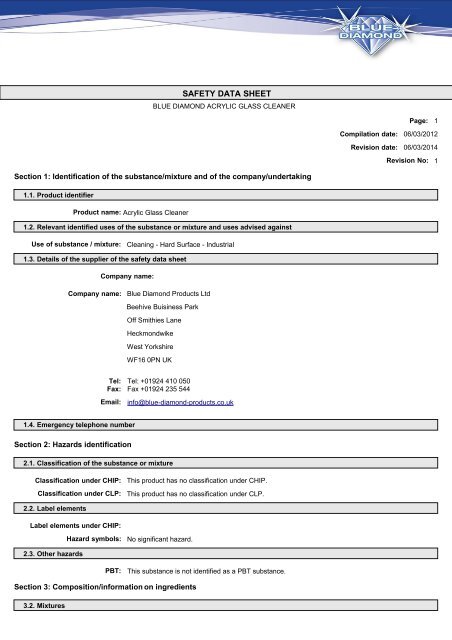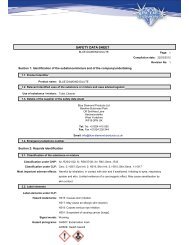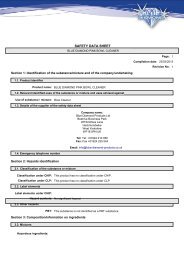Blue Diamond Acrylic Glass Cleaner
Blue Diamond Acrylic Glass Cleaner
Blue Diamond Acrylic Glass Cleaner
You also want an ePaper? Increase the reach of your titles
YUMPU automatically turns print PDFs into web optimized ePapers that Google loves.
SAFETY DATA SHEET<br />
BLUE DIAMOND ACRYLIC GLASS CLEANER<br />
Page: 1<br />
Compilation date: 06/03/2012<br />
Revision date: 06/03/2014<br />
Revision No: 1<br />
Section 1: Identification of the substance/mixture and of the company/undertaking<br />
1.1. Product identifier<br />
Product name: <strong>Acrylic</strong> <strong>Glass</strong> <strong>Cleaner</strong><br />
1.2. Relevant identified uses of the substance or mixture and uses advised against<br />
Use of substance / mixture: Cleaning - Hard Surface - Industrial<br />
1.3. Details of the supplier of the safety data sheet<br />
Company name:<br />
Company name: <strong>Blue</strong> <strong>Diamond</strong> Products Ltd<br />
Beehive Buisiness Park<br />
Off Smithies Lane<br />
Heckmondwike<br />
West Yorkshire<br />
WF16 0PN UK<br />
Tel: Tel: +01924 410 050<br />
Fax: Fax +01924 235 544<br />
Email: info@blue-diamond-products.co.uk<br />
1.4. Emergency telephone number<br />
Section 2: Hazards identification<br />
2.1. Classification of the substance or mixture<br />
Classification under CHIP: This product has no classification under CHIP.<br />
Classification under CLP: This product has no classification under CLP.<br />
2.2. Label elements<br />
Label elements under CHIP:<br />
Hazard symbols: No significant hazard.<br />
2.3. Other hazards<br />
PBT: This substance is not identified as a PBT substance.<br />
Section 3: Composition/information on ingredients<br />
3.2. Mixtures
SAFETY DATA SHEET<br />
BLUE DIAMOND ACRYLIC GLASS CLEANER<br />
Page: 2<br />
Hazardous ingredients:<br />
PROPAN-2-OL<br />
EINECS CAS CHIP Classification CLP Classification Percent<br />
200-661-7 67-63-0 F: R11; Xi: R36; -: R67 Flam. Liq. 2: H225; Eye Irrit. 2: H319;<br />
STOT SE 3: H336<br />
1-10%<br />
Section 4: First aid measures<br />
4.1. Description of first aid measures<br />
Skin contact: Wash immediately with plenty of soap and water. Seek medical aid if irritation or<br />
discomfort persists.<br />
Eye contact: Promptly wash eyes with plenty of water while lifting the eye lids. Remove any contact<br />
lenses from the eyes. Continue to rinse for at least 15 minutes. Obtain medical attention<br />
if any discomfort continues.<br />
Ingestion: Wash out mouth with water. Do not induce vomiting. Consult a doctor.<br />
Inhalation: Irritating to resiratory system. Vapour may effect central nervous system and cause<br />
headache, discomfort, vomiting or intoxication If the liquid enters the lungs - consult a<br />
doctor immediately.<br />
4.2. Most important symptoms and effects, both acute and delayed<br />
Skin contact: There may be mild irritation at the site of contact.<br />
Eye contact: There may be irritation and redness.<br />
Ingestion: There may be irritation of the throat.<br />
4.3. Indication of any immediate medical attention and special treatment needed<br />
Section 5: Fire-fighting measures<br />
5.1. Extinguishing media<br />
Extinguishing media: Suitable extinguishing media for the surrounding fire should be used.<br />
5.2. Special hazards arising from the substance or mixture<br />
Exposure hazards: In combustion emits toxic fumes.<br />
5.3. Advice for fire-fighters<br />
Advice for fire-fighters: Wear self-contained breathing apparatus. Wear protective clothing to prevent contact<br />
with skin and eyes.<br />
Section 6: Accidental release measures<br />
6.1. Personal precautions, protective equipment and emergency procedures<br />
Personal precautions: Refer to section 8 of SDS for personal protection details.<br />
[cont...]
SAFETY DATA SHEET<br />
BLUE DIAMOND ACRYLIC GLASS CLEANER<br />
Page: 3<br />
6.2. Environmental precautions<br />
Environmental precautions: Do not discharge into drains or rivers. Contain the spillage using bunding.<br />
6.3. Methods and material for containment and cleaning up<br />
Clean-up procedures: Absorb into dry earth or sand. Transfer to a closable, labelled salvage container for<br />
disposal by an appropriate method.<br />
6.4. Reference to other sections<br />
Section 7: Handling and storage<br />
7.1. Precautions for safe handling<br />
Handling requirements: Ensure there is sufficient ventilation of the area. Avoid the formation or spread of mists in<br />
the air.<br />
7.2. Conditions for safe storage, including any incompatibilities<br />
Storage conditions: Store in cool, well ventilated area. Keep container tightly closed.<br />
Suitable packaging: Must only be kept in original packaging.<br />
7.3. Specific end use(s)<br />
Section 8: Exposure controls/personal protection<br />
8.1. Control parameters<br />
Hazardous ingredients:<br />
PROPAN-2-OL<br />
Workplace exposure limits:<br />
Respirable dust<br />
State 8 hour TWA 15 min. STEL 8 hour TWA 15 min. STEL<br />
UK 999 mg/m3 1250 mg/m3 - -<br />
8.2. Exposure controls<br />
Engineering measures: Ensure there is sufficient ventilation of the area.<br />
Respiratory protection: With normal ventilation and usage, respiratory protection is not required. Do not create<br />
and breath spray mist.<br />
Hand protection: Protective gloves.<br />
Eye protection: Safety glasses.<br />
Skin protection: Protective clothing.<br />
Section 9: Physical and chemical properties<br />
9.1. Information on basic physical and chemical properties<br />
State: Liquid<br />
Colour: Green<br />
Odour: Barely perceptible odour<br />
[cont...]
Viscosity:Non-viscous<br />
9.2. Other information<br />
SAFETY DATA SHEET<br />
BLUE DIAMOND ACRYLIC GLASS CLEANER<br />
Page: 4<br />
Other information: Not applicable.<br />
Section 10: Stability and reactivity<br />
10.1. Reactivity<br />
10.2. Chemical stability<br />
Chemical stability: Stable under normal conditions.<br />
10.3. Possibility of hazardous reactions<br />
10.4. Conditions to avoid<br />
Conditions to avoid: Heat.<br />
10.5. Incompatible materials<br />
Materials to avoid: Strong oxidising agents<br />
10.6. Hazardous decomposition products<br />
Haz. decomp. products: In combustion emits toxic fumes.<br />
Section 11: Toxicological information<br />
11.1. Information on toxicological effects<br />
Toxicity values: Not applicable.<br />
Symptoms / routes of exposure<br />
Skin contact: There may be mild irritation at the site of contact.<br />
Eye contact: There may be irritation and redness.<br />
Ingestion: There may be irritation of the throat.<br />
Section 12: Ecological information<br />
12.1. Toxicity<br />
Ecotoxicity values: Not applicable.<br />
12.2. Persistence and degradability<br />
Persistence and degradability: Largely biodegradable.<br />
12.3. Bioaccumulative potential<br />
Bioaccumulative potential: The product has low potential for bioaccumulation.<br />
12.4. Mobility in soil<br />
Mobility: Soluble in water.<br />
12.5. Results of PBT and vPvB assessment<br />
PBT identification: This substance is not identified as a PBT substance.<br />
[cont...]
SAFETY DATA SHEET<br />
BLUE DIAMOND ACRYLIC GLASS CLEANER Page: 5<br />
12.6. Other adverse effects<br />
Section 13: Disposal considerations<br />
13.1. Waste treatment methods<br />
Disposal operations: Transfer to a suitable container and arrange for collection by specialized disposal<br />
company. Dispose of waste and residues in accordance with local authority<br />
requirements.<br />
NB: The user's attention is drawn to the possible existence of regional or national<br />
regulations regarding disposal.<br />
Section 14: Transport information<br />
Transport class: This product does not require a classification for transport.<br />
Section 15: Regulatory information<br />
15.1. Safety, health and environmental regulations/legislation specific for the substance or mixture<br />
15.2. Chemical Safety Assessment<br />
Chemical safety assessment: A chemical safety assessment has not been carried out for the substance or the mixture<br />
by the supplier.<br />
Section 16: Other information<br />
Other information<br />
Other information: This safety data sheet is prepared in accordance with Commission Regulation (EU) No<br />
453/2010.<br />
* indicates text in the SDS which has changed since the last revision.<br />
Phrases used in s.2 and 3: H225: Highly flammable liquid and vapour.<br />
H319: Causes serious eye irritation.<br />
H336: May cause drowsiness or dizziness.<br />
R11: Highly flammable.<br />
R36: Irritating to eyes.<br />
R67: Vapours may cause drowsiness and dizziness.<br />
Legal disclaimer: The above information is believed to be correct but does not purport to be all inclusive<br />
and shall be used only as a guide. This company shall not be held liable for any<br />
damage resulting from handling or from contact with the above product.<br />
[final page]







